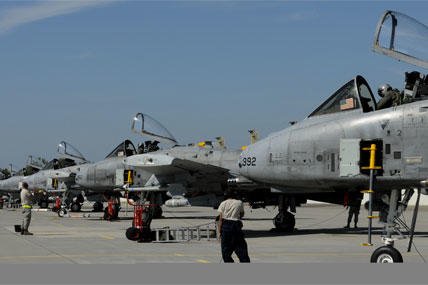NAMEST AIR BASE, Czech Republic -- The U.S. Air Force joins 15 other nations in Ramstein Rover 2012 from Sept. 5-22.
RARO 12 is a NATO exercise focusing on forward air control and close air support capabilities.
A-10 Thunderbolt IIs from the 81st Fighter Squadron, out of Spangdahlem Air Base, Germany, are flying throughout the exercise to provide close air support for various forward air control training missions.
The purpose of the exercise is to establish standardization and interoperability for forward air control and close air support missions for nations that may work together in contingency operations. In that regard, the squadron is working with working the militaries of the United Kingdom, Turkey, Slovenia, Slovakia, Poland, Norway, the Netherlands, Latvia, Italy, Greece, Germany, France, Estonia, Belgium and the Czech Republic.
"It's imperative we train with our NATO partners to establish common standards and terminology," said Lt. Col. Clinton Eichelberger, 81st Fighter Squadron commander. "We all need to be very clear of what has to happen when putting weapons on the ground in close proximity to friendly forces."
Because A-10 squadrons often work with NATO partners in contingency operations, it's important for them to build partnerships and create standardized tactics, techniques and procedures in a training environment, officials said. This way, they can work together to execute combatant commander's missions seamlessly in contingency operations.
The A-10s role in close air support is critical to forward air control missions because the pilots work hand-in-hand with the air controllers on the ground to identify threats and targets while mitigating risks to civilians in contingency operations, officials said.
"The A-10 aircraft is a backbone to close air support operations within NATO," said German air force Col. Harry H. Schnell, RARO 12 exercise director. "To have the A-10s on board gives me the opportunity to give the best flying asset available to train the guys on the ground. This pairing of the A-10s and the guys on the ground is what we may expect in-theater the most. "
The forward air controller is also a critical link to the A-10's close air support mission because they control where the weapons deploying from the aircraft go by telling the pilots where the targets are and determining a safe distance from which to launch their weapons.
"Without forward air controllers and joint terminal attack controllers on the ground we wouldn't be able to do what we do," Eichelberger said. "A majority of the work we do is close air support, and close air support would not exist without communication with the ground commander. ... That communication piece is the forward air controller or the joint terminal attack controller."
Air controllers must be able to execute coordinates for air support immediately because enemy forces can be established as threats without any given notice. Once the threat is established, air support has to be able to support the troops on the ground without firing at friendly forces or civilians.
The training at RARO 12 helps both air controllers and pilots establish procedures and share techniques that will mitigate risks to non-targets.
"The greatest benefit of this exercise is to send JTAC and FAC teams to the theater and know that they are all working on the same foundation -- using the same procedures, sharing knowledge of equipment and knowledge of what air assets are capable of," said Schnell.


























